Autonomous robotics are changing golf with robotic caddies, drones, AI swing trackers, and smart carts. Discover how technology is transforming golf courses, enhancing practice, and elevating the player experience across the United States.
Autonomous robotics are changing golf with robotic caddies, drones, AI swing trackers, and smart carts. Discover how technology is transforming golf courses, enhancing practice, and elevating the player experience across the United States.
Tiger Woods - Full Swing Golf Simulators
Golf has always been a sport where tradition and precision reign supreme. Yet in the last decade, technology has begun to take a central role—not just in how golfers practice and play, but also in how courses are maintained and how fans experience the game. From autonomous robotics shaping course management to high-tech training systems embraced by some of the world’s biggest golf stars, the sport is moving into an exciting new era.
Autonomous systems and robotics are starting to shape the golf industry, especially in course management, equipment, and even player experience. Here’s a breakdown of how they’re being used:
Maintaining a golf course is labor-intensive and costly, but robotics is transforming that reality. Autonomous mowers already cut fairways and greens with precision, while drones equipped with sensors can scan turf health, monitor irrigation, and detect disease. In the near future, we may see robots that seed grass, repair divots, and remove weeds with little to no human supervision. For course owners, this means lower maintenance costs and more sustainable operations.
Autonomous irrigation drones – drones that detect dry patches and deliver water/fertilizer only where needed. Weed & pest robots – turf-protecting robots that spot and remove weeds or pests using AI recognition, reducing chemical use. 24/7 robotic groundskeepers – robots that can mow, seed, and even repair divots automatically.
Autonomous Player Support. Self-driving golf carts – carts that take players hole-to-hole without steering, using GPS + sensors. AI robotic caddies – not just carrying clubs, but giving strategy, yardage, and club recommendations via AI analysis. Autonomous tee assistants – robotic arms that place and retrieve balls at the tee box.
Training & Performance Enhancement. Swing replication robots – simulate a pro golfer’s swing so learners can feel the movement physically. AI shot correction drones – drones that hover and film from multiple angles, then instantly give corrections via app. Robotic sparring partner – machines that simulate different playing conditions (wind, resistance, slope) for practice.
Fan & Entertainment Innovations. Autonomous ball-retrieving drones – for driving ranges, fast and fun to watch compared to standard ball pickers. Interactive robotic spectators – robots that can clap, cheer, or broadcast live stats during tournaments. Augmented reality golf assistants – small robots or drones that project AR visual lines showing ball trajectory or putting guidance.
Business & Operational Efficiency. Robot-operated pro shops – automated club rental & ball dispensing systems. Autonomous delivery bots – delivering snacks & drinks directly to players on the course. Fully automated driving ranges – from robotic tee placement, ball collection, cleaning, and restocking without staff.
Golf Caddies & Autonomous Carts. Smart golf carts – GPS-enabled, some operate semi-autonomously, navigating golfers to holes, suggesting club choices, or showing course layouts. Robotic golf caddies – Compact robots follow golfers around the course, carrying clubs and gear (e.g., Club Car Tempo Walk, Stewart Golf X10 Follow).
Training & Swing Analysis Robots. Swing robots – Machines like the Golf Laboratories “Iron Byron” robot simulate perfect swings to test clubs and balls. AI-powered training robots – Motion-tracking robots and systems analyze a golfer’s swing in real-time, providing instant feedback and drills.
Retail & Driving Range Robotics. Automated driving ranges – Systems like Toptracer use cameras and AI to track every shot, while robotic arms can automatically tee up balls. Club fitting robots – Some facilities use robotic simulators to match players with optimized clubs based on swing data.
Autonomous drones for live golf broadcasts – Could replace some traditional camera setups for more dynamic viewing angles. AI robotic coaches – Combining swing sensors, biomechanics, and autonomous simulations for personal training. Fully automated golf courses – Where mowing, irrigation, ball collection, and cart operations are robotic-driven.
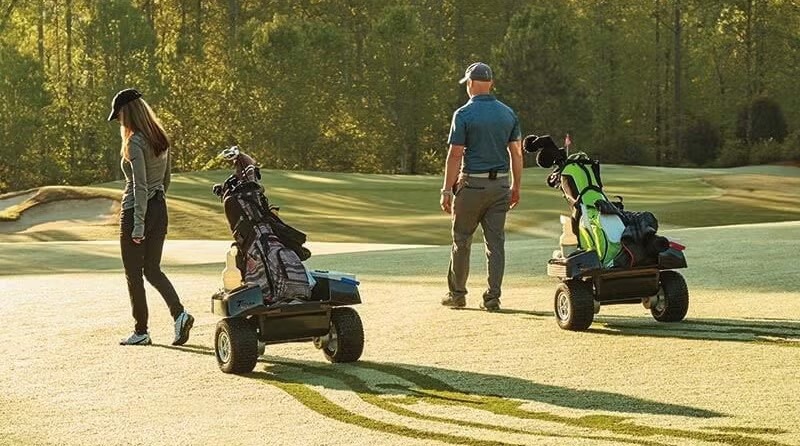
Golf has always been known as a game of patience, precision, and tradition. But behind the perfectly trimmed fairways and seamless playing experiences lies an industry that is steadily embracing innovation. Autonomous robotics is reshaping golf—from the way courses are maintained to how players train, move around, and even enjoy a round of 18 holes.
As robotics and AI continue to evolve, golf is becoming one of the most interesting spaces where tradition meets cutting-edge technology.
Autonomous Caddies and Golf Carts. Caddies have always been the trusted companions of golfers, but robotics is taking on that role in new ways. Robotic golf caddies that follow players around the course, carrying clubs and equipment, are becoming popular. Meanwhile, self-driving golf carts use GPS and obstacle-detection sensors to guide players smoothly from one hole to the next. Beyond convenience, these innovations are about creating a seamless and enjoyable golfing experience.
Training and Player Performance. Robotics isn’t just helping the game—it’s also helping players improve. Machines like swing robots replicate professional-level swings for equipment testing, but the next step is AI-driven training robots. Imagine a robot that records your swing, analyzes biomechanics in real-time, and provides instant corrections. Drones could hover nearby, capturing every angle of your shot and offering feedback on trajectory, stance, and follow-through. Some concepts even propose swing replication robots, allowing golfers to physically experience the motions of a professional swing.
Enhancing the Fan and Driving Range Experience. Driving ranges and entertainment facilities like Topgolf are experimenting with automation. Robots can automatically tee balls, collect them, clean them, and restock bays, creating a fully automated experience. On the course, delivery robots could bring snacks and beverages directly to golfers, while drones might one day film tournaments from above, offering dynamic angles for spectators. Even fan engagement could get a boost—imagine interactive robots on the sidelines cheering or displaying live stats.
While golf will always remain a sport of skill and tradition, the integration of autonomous robotics is inevitable. For players, it means convenience and smarter training tools. For course operators, it means lower costs and greener operations. And for fans, it promises an entirely new way to experience the sport.
Golf is no longer just about clubs, balls, and greens—it’s about how innovation can blend with tradition to create the future of the game. Autonomous robotics is considered a game changer in golf because it touches almost every part of the sport—operations, player experience, and even fan engagement. Here’s why it stands out:
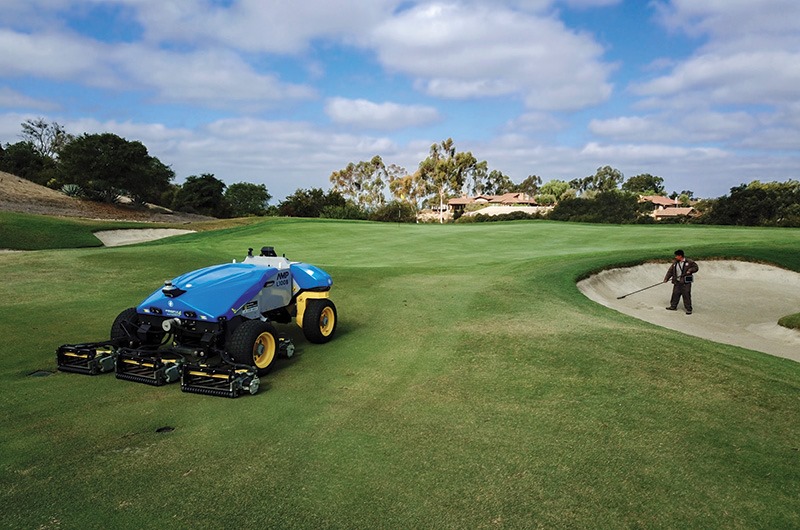
Maintaining a course is expensive and labor-intensive. Robotic mowers, ball collectors, and drones drastically cut down labor hours and operational costs. Automation ensures consistent quality—greens are always trimmed to the right height, turf is healthier, and ball collection is nonstop. This is especially important as many golf courses face staffing shortages and rising maintenance costs.
Sustainability & Smarter Resource Use. Robotics can reduce water, fertilizer, and pesticide usage by targeting only the areas that need care. Electric-powered robots and drones lower carbon emissions compared to heavy machinery. This makes golf more eco-friendly, which is critical as the industry faces scrutiny for resource consumption.
Enhanced Player Experience. Autonomous caddies and self-driving carts remove the hassle of carrying clubs or navigating the course. Training robots and AI swing analyzers give instant feedback, helping golfers of all levels improve faster. Delivery bots and automation at ranges mean golfers spend more time enjoying the game, less time waiting or setting up.
Innovation in Training & Performance. Swing robots (like RoboGolfPro) physically guide golfers to feel the “perfect swing.” AI-powered systems track every shot, giving real-time stats and recommendations like a virtual coach. This brings pro-level training to amateurs, making golf more accessible and engaging.
Fan & Entertainment Evolution. Drones offer new broadcast angles, making tournaments more exciting to watch. Gamified driving ranges (Topgolf, Inrange Golf) combine robotics and AI to attract new, younger audiences. Interactive robotic assistants or delivery bots can make a round feel futuristic and fun.
Future-Proofing the Game. With declining memberships at some traditional clubs, robotics helps cut costs and attract new players through tech-driven experiences. Golf is able to balance tradition with innovation, ensuring it stays relevant in a digital-first world.
Autonomous robotics is a game changer in golf because it makes the sport more efficient, sustainable, player-friendly, and engaging for fans, while lowering costs for operators.
Smarter Golf Course Maintenance. Running a golf course requires massive labor and resources, but autonomous machines are helping owners reduce costs while keeping conditions pristine.
Husqvarna Automower / Echo Robotics TM-2000. Robotic lawnmowers designed for golf courses, working autonomously to trim fairways and greens. Autonomous mowers (like Husqvarna or Echo Robotics) maintain fairways and greens with minimal supervision, saving labor costs and ensuring consistent grass height. Companies like Husqvarna Automower and Echo Robotics TM-2000 have designed robotic mowers specifically for golf courses. These machines can trim grass consistently day and night, ensuring fairways and greens are always in peak condition without needing constant human supervision.
Automated Ball Collectors (e.g., BallPicker by Echo Robotics). Robots that roam driving ranges, pick up balls, and deliver them back to a collection system. Automated Ball Collectors Ball collection robots – Driving ranges often use autonomous ball pickers that roam fields, collect balls, and return them to a washing/loading system. Driving ranges are already adopting products like the BallPicker by Echo Robotics, which autonomously roams the range, collects golf balls, and delivers them to a washing and dispensing system.
Turf Monitoring Drones (e.g., PrecisionHawk, DJI drones with NDVI sensors). Drones that scan turf for health, irrigation efficiency, and early signs of disease. Drones for Turf Monitoring Drones for turf monitoring – Equipped with sensors, drones scan large courses to check grass health, irrigation efficiency, and pest/disease issues. Drones such as DJI platforms with NDVI sensors or PrecisionHawk systems provide overhead analysis of turf health, irrigation, and pest detection. This not only saves time but also ensures early action against diseases, reducing chemical use.
These innovations give golf course operators a double win: lower operational costs and more sustainable maintenance practices.
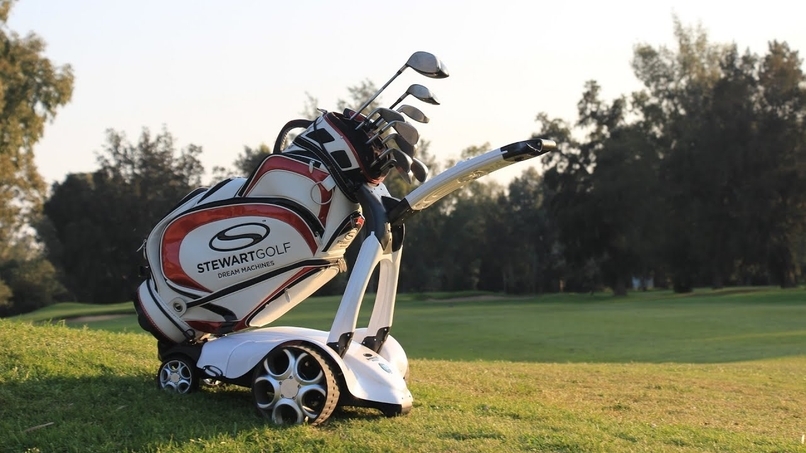
Autonomous Caddies and Smart Golf Carts. The role of the caddie has always been central to golf, but robotics is adding new possibilities.
Robotic Golf Caddies. Devices like the Stewart Golf X10 Follow and Club Car Tempo Walk can follow players across the course using GPS or motion sensors. They carry clubs, keep pace with the golfer, and provide a hands-free experience. Robotic caddies that follow golfers using sensors or GPS, carrying clubs and gear.
Self-Driving Golf Carts. Fleet systems such as Club Car Connected and Yamaha Drive² Fleet are introducing autonomous navigation. These carts can transport players seamlessly between holes, display GPS yardage, and even track scores digitally. Autonomous Golf Carts (e.g., Club Car Connected, Yamaha Drive² Fleet). Self-driving carts with GPS mapping, collision avoidance, and digital score tracking. For players, this means less focus on logistics and more focus on enjoying the game.
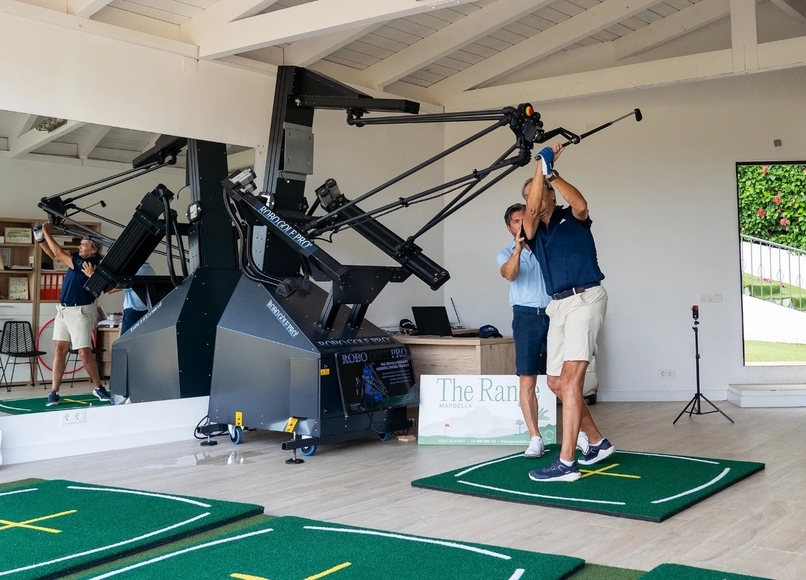
Robotics for Training and Player Development. Perhaps one of the most exciting applications of robotics in golf is training.
Swing Robots. The legendary Iron Byron swing robot from Golf Laboratories replicates the perfect golf swing for equipment testing. Its consistency makes it invaluable for club manufacturers. Iron Byron Swing Robot (Golf Laboratories). A robot that replicates human golf swings to test clubs and balls consistently.
Guided Swing Trainers. Systems like RoboGolfPro use robotic arms to guide a golfer’s body through the “ideal swing.” This builds muscle memory by physically teaching the correct motion. Robotic Swing Trainers (concepts like RoboGolfPro). Robotic arms that guide a player’s body through the “ideal swing path,” teaching muscle memory.
AI-Powered Swing Tracking. While not robots in the traditional sense, systems like Toptracer and Arccos Caddie combine AI, cameras, and automation to deliver real-time shot analysis and training insights. AI-Powered Swing Tracking (e.g., Toptracer, Arccos Caddie)
While not full robots, these systems use AI + automation to analyze shots and provide insights. With these tools, players of all skill levels can get instant, personalized coaching that once required a dedicated trainer.
Automation at the Driving Range. Driving ranges are often the first place golfers see robotics in action.
Power Tee. An automated system that reloads balls and adjusts tee height without manual effort, allowing players to focus purely on their swing. System that adjusts ball height and reloads balls without manual setup.
Topgolf. Entertainment-driven ranges combine sensors, ball tracking, and automated systems to gamify practice sessions. From shot tracking to automated ball management, these systems are paving the way for fully automated driving ranges.
Automated Range Management (Topgolf / Inrange Golf) Integration of sensors, robotics, and AI to track shots, dispense balls, and create gamified experiences. Automation here isn’t just about efficiency—it’s about making golf more engaging and accessible for new audiences.
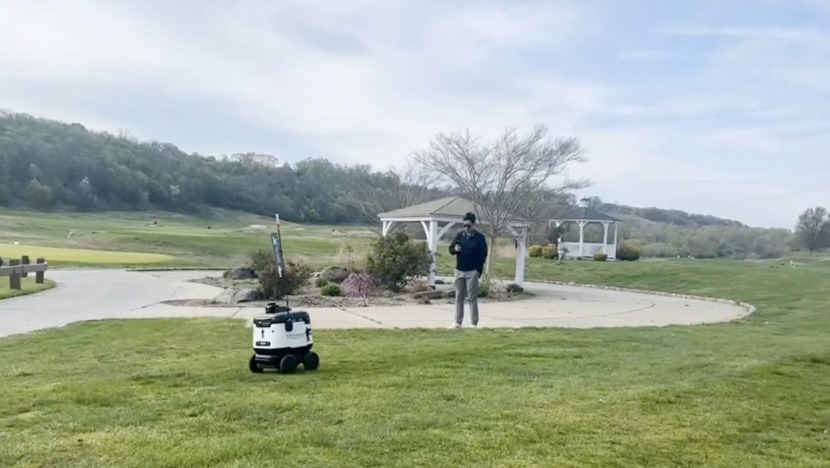
Enhancing the Fan and Hospitality Experience. Autonomous robotics is also finding its way into fan engagement and on-course services.
Delivery Robots. Experimental on-course delivery bots are designed to bring drinks and snacks directly to players, reducing wait times and enhancing comfort. On-Course Delivery Robots (prototype stage). Small autonomous carts delivering drinks and snacks to players on the course.
Broadcast Drones. Already being used in professional tournaments, drones capture aerial shots and provide live feeds that would be impossible with traditional camera towers. Broadcast Drones
Used for aerial tournament coverage, providing dynamic live feeds without traditional camera towers.
Interactive Robotics. Conceptual projects even imagine robots cheering, displaying live stats, or serving as interactive “guides” during major tournaments. For fans, robotics promises to make golf more immersive and entertaining, both on-site and at home.
The Future of Golf and Robotics
The integration of robotics into golf is still in its early stages, but the direction is clear: a smarter, more sustainable, and more enjoyable game for everyone involved.
· For course operators, robotics offers cost savings, efficiency, and environmental benefits.
· For players, it means smarter training, convenience on the course, and enhanced overall experience.
· For fans, it delivers a more dynamic, technology-enhanced way to watch and interact with the sport.
Golf will always be a sport rooted in tradition, but as autonomous robotics becomes part of its fabric, it’s clear that the future of the game will be shaped not just by swings and putts—but by technology working quietly in the background to keep the game alive, accessible, and exciting.
Golf courses and facilities in the United States that are using autonomous robotics or advanced technology in course maintenance and operations:
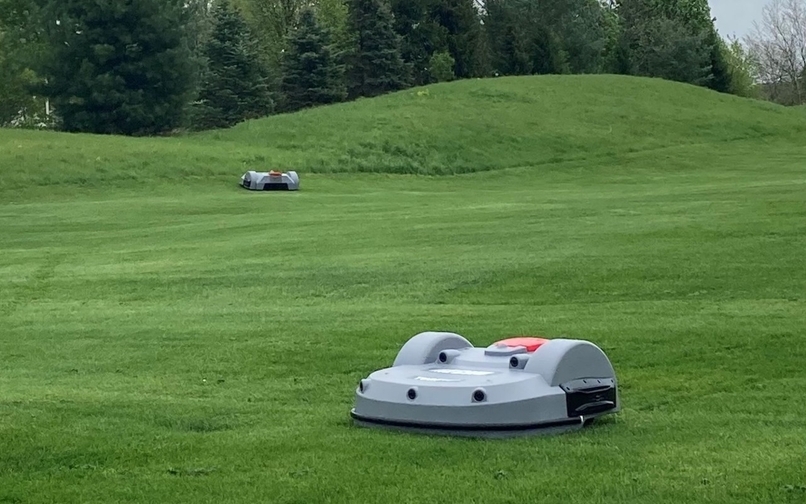
Bull Valley Golf Club (Woodstock, Illinois)
Implements an Echo Robotics unit that operates both as an autonomous mower and a ball-picker—roaming the driving range, collecting up to 12,500 balls per day, and depositing them at a base station. Staff monitor the robot via laptop or smartphone; the system saves the club approximately $25,000 annually and allows the range to remain open during maintenance.
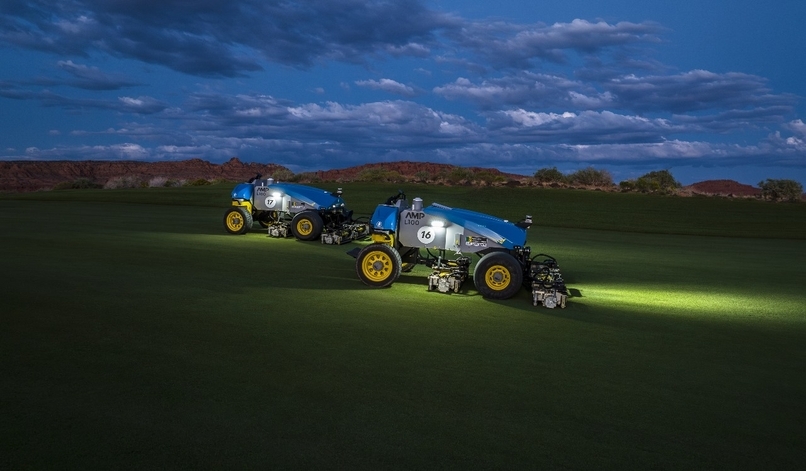
Black Desert Resort Course (Ivins, Utah)
At the PGA Tour’s Black Desert Championship, the course introduced autonomous mowing platforms (AMPs) by FireFly Automatix—4 large, all-electric machines that handle fairway mowing. These robots freed staff to focus on detailed tasks like bunker maintenance, improving both efficiency and presentation.
With robotic ball pickers, automated tees, and AI-driven scoring, ranges are becoming fully automated hubs for fun and practice.
Celebrities Leading the Tech Movement in Golf
Technology in golf is not just for operators—it has become central to how the world’s top players train and perform.
three high-profile golf stars known for embracing advanced technology—including autonomous robotics and simulation systems—to elevate their practice and performance:
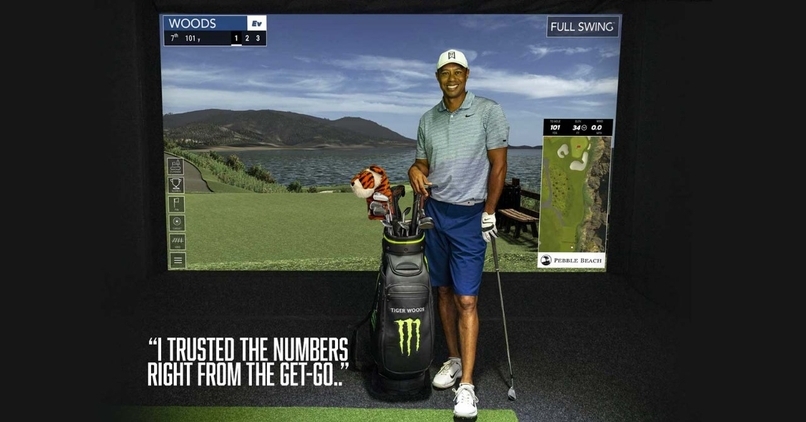
Tiger Woods - Tiger Woods has long been a pioneer in this space. He practices with the Full Swing Pro Series simulator and the Full Swing KIT Launch Monitor, which delivers detailed shot data. He also co-founded the tech-forward TGL (Tech-Infused Golf League), which uses advanced simulators and Toptracer tracking to bring fans a new style of competition. What he uses: Full Swing Pro Series Simulator & VirtualGreen — Tiger has said that consistent practice on his Full Swing simulator has been key to his comeback, helping him fine-tune shot shaping and trajectories, whether indoors or at home. Full Swing KIT Launch Monitor — He relies on this advanced device, which provides 16 data points on club and ball movement, to prepare even on real ranges like St. Andrews. TGL (Tech-Infused Golf League) — As co-founder and investor, Tiger is central to TGL, where players hit into massive simulators using ball-tracking systems like Toptracer in an entirely high-tech environment.

Rory McIlroy - Rory McIlroy is another outspoken advocate of technology in golf. He regularly trains with TrackMan and GCQuad launch monitors, even taking part in a memorable swing-off against a golf robot. Like Woods, McIlroy is a co-founder of TGL and a firm believer that technology is the future of golf engagement. What he uses: Launch monitors & simulators — Rory uses high-end systems like TrackMan and Foresight GCQuad for data-driven swing analysis during practice. Swing robot challenge — In a memorable showdown, Rory battled Golf Laboratories’ swing robot in a fun yet competitive range drill—showcasing his willingness to engage with robotics in golf. TGL Committed Technologist — Like Tiger, Rory co-founded TGL. He sees tech-driven golf as the future and was instrumental in adopting tools like Toptracer and Full Swing in TGL’s high-energy format.
These players prove that robotics and analytics are not gimmicks—they are tools that can extend careers, sharpen skills, and reinvent how golf is played and watched.
Fans, too, are seeing golf through a new lens thanks to robotics. Drones now provide dynamic broadcast angles, while experimental delivery robots bring snacks and drinks directly to players on the course. In the future, interactive robotics could even serve as live stat displays or virtual guides during tournaments. For spectators, this means a more immersive and tech-rich experience that complements the traditions of the sport.
What makes autonomous robotics a true game changer in golf is its impact across the board. Courses become cheaper and greener to run. Players gain smarter tools for practice and performance. Fans enjoy richer experiences both on-site and at home.
Golf will always honor its traditions, but as technology continues to advance, the sport is proving that innovation can coexist with heritage. Autonomous robotics may not change the swing of a putter or the weight of a club, but it is quietly transforming everything around them—ensuring that golf remains efficient, sustainable, and exciting for generations to come.